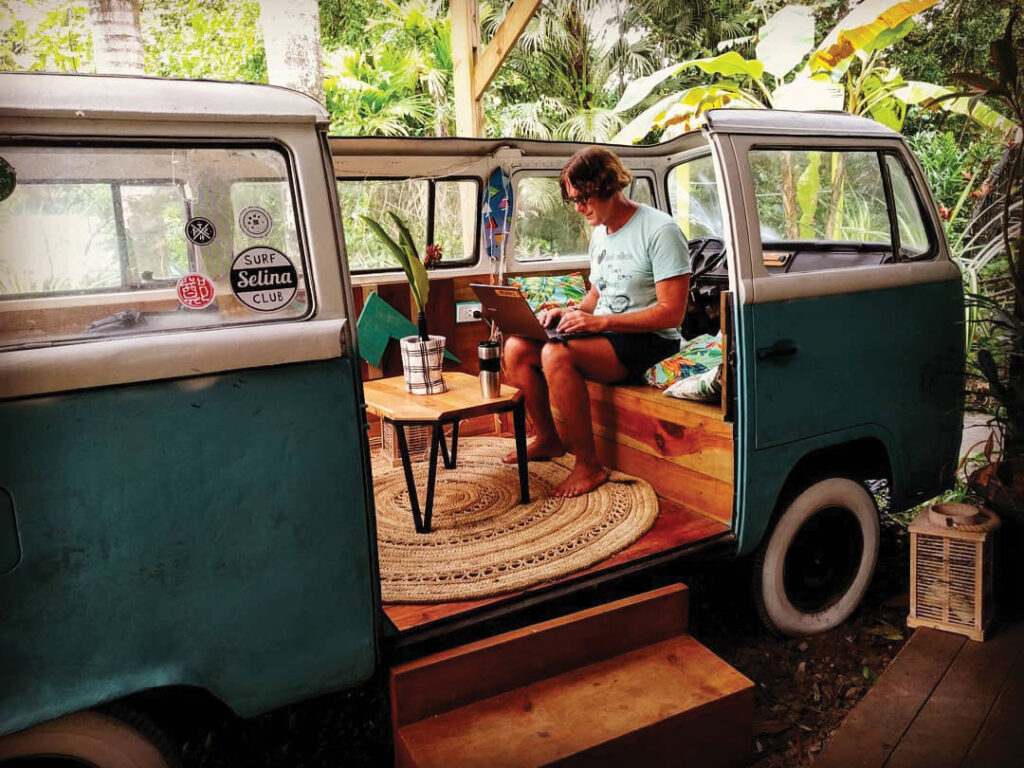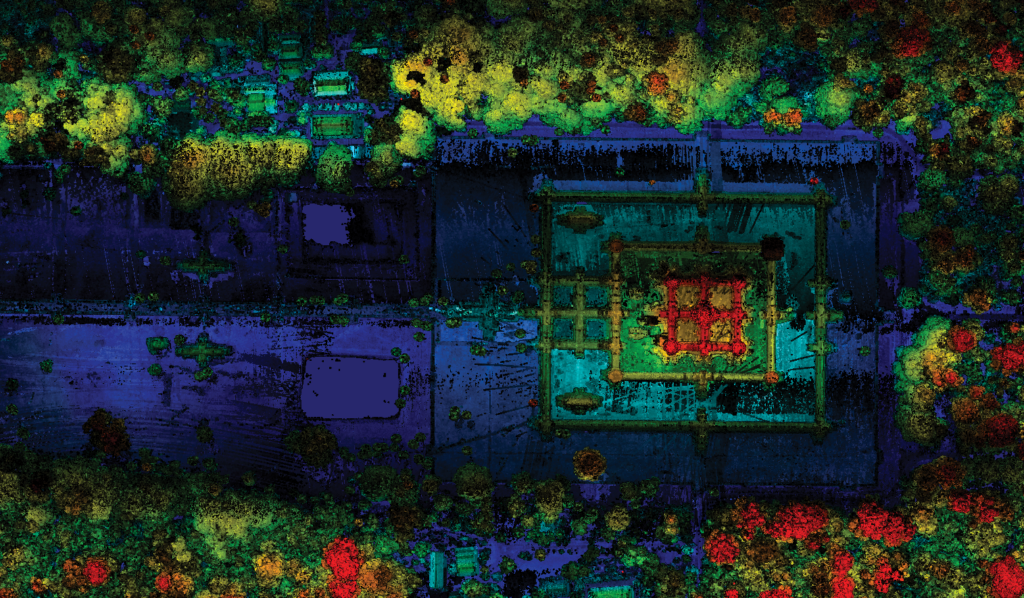Founded in 1952 20 km east of San Francisco Bay and 20 km northeast of Silicon Valley, Lawrence Livermore National Laboratory (LLNL) applies science and technology to make the world a safer place. Its defining responsibility is ensuring the safety, security and reliability of the nation’s nuclear deterrent1. Often in the news, it recently caused a worldwide stir with an announcement from its National Ignition Facility about a new approach to nuclear fusion2. It’s equally apparent that the scientists and engineers who form the backbone of LLNL are the very best—the intellectual air is rarified indeed. To work at LLNL, then, would be a feather in any scientist’s or engineer’s cap.
Martin Isenburg’s motivation for joining LLNL, however, was much simpler: he loved the Bay Area and wanted to stay. It was summer 2007, he was 35, holding a MSc from the University of British Columbia, a PhD from the University of North Carolina Chapel Hill and a freshly minted post-doc from the University of California Berkeley. An extraordinarily brilliant scientist, he received job offers from all over the world, including the National University of Singapore, Hong Kong University, and the Environmental Systems Research Institute (ESRI). Martin had been a nomad all his life, but he fell in love with the Bay Area while he was a post-doc at Berkeley. He felt so comfortable in the Bay Area that he wanted to settle down and stay there for the rest of his life.
Home to the world’s most powerful laser, LLNL was honing the cutting-edge of photonics science. Martin was employed as a computer scientist from July 2007 to July 2010. His duties included: parallel mesh smoothing with Mesquite software; surveillance with the Constant Hawk airborne intelligence system; streaming and parallel ghost node generation; and land-mine detection using lidar and radar.
Martin’s grand vision for streaming geometric processing had begun to coalesce on the heels of his PhD studies at the University of North Carolina, which led to work with Jonathan Shewchuk at Berkeley3. The duo pursued technical feats such as “streaming Delaunay” capabilities4, synonymous with the famously efficient triangulation method that would ultimately underpin Martin’s commercial solutions, namely “blast2DEM”, part of the LAStools package. Martin’s idea, even at that early stage, was to create lidar-processing tools that would enable rapid transition of lidar from raw data to deliverable products, all on a vanilla desktop or laptop. One of the best known components remains the compression of LAS lidar data files into LAZ, which is fast and saves remarkable amounts of storage space5. Indeed, even before joining LLNL, Martin had taken his code and tools, zipped them into a folder called LAStools, and put it on his website for others to use. Later he added the LAZ compression.
The dark turn
Martin’s first two years at LLNL went well. He bought an old farmhouse in downtown Livermore where he grew vegetables and raised chickens.
Early in 2010 however, he was afflicted with a severe bipolar disorder, which dogged him throughout his days. The predisposition to this was genetic: his mother had suffered from this insidious disease for decades before she died in 2007. Martin was enveloped by a strong manic episode that lasted several months. Owing to his untreated disorder, he began behaving strangely in society and on social media. He sent long, bizarre, and sometimes offensive emails to many recipients, spreading paranoid accusations and alienating his co-workers and many of his friends. He was out of control and acting like a different person.
Martin’s family, especially his father and sister, as well as many of his friends, recognized the signs of his growing insanity and tried everything they could to help him, but his mania was simply too strong—and Martin was too smart: he successfully tricked the doctors every time he was hospitalized. He refused treatment, because he did not realize that he was ill, which is characteristic of mania.
Owing to his odd behavior, Martin became increasingly unpopular. He verbally abused people and business owners in Livermore and aggressively solicited funding for his project, obsessively describing his plans to build an urban chicken farm in which he would use laser-scanning and surface reconstruction algorithms to transmit online, 24-hours per day, three-dimensional live animations of his chickens in action to the world—“laser chickens”. Irritated by his behavior and unpredictability, people became increasingly afraid of him, though he never harmed a fly.
When Martin’s mania reached its peak in spring 2010, a chain of coincidences connected him to Silke Kämmerer, the current CEO of rapidlasso. Martin sent numerous friend requests to people on Facebook. One of these inquiries reached Silke while on a business trip in Turkmenistan. Silke explained: “I accidentally accepted Martin’s request, mistaking him for someone else. We’re from neighboring villages in Germany, so we had some common acquaintances, including one who joined the Turkmenistan journey. I soon realized that I didn’t know Martin. He was frequently posting about his obsessive ideas on Facebook. He seemed to be smart, but his demeanor was weird. However, I didn’t kick him out and sometimes even communicated with him. To me personally he was always very respectful.”
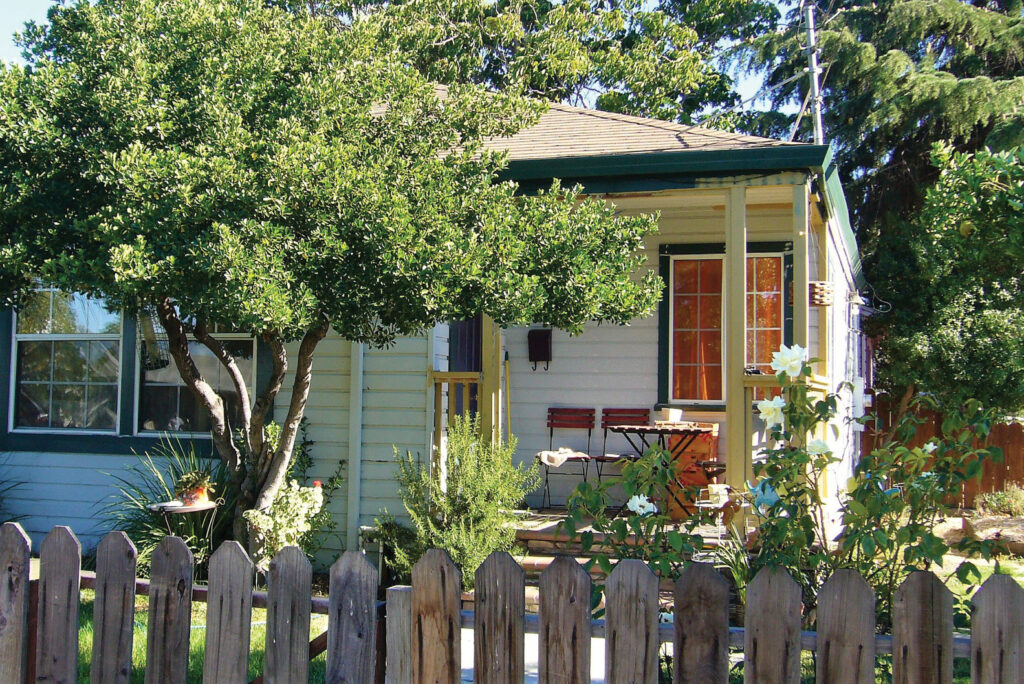
Martin’s house in downtown Livermore. He loved this house—the first home he had owned—and it was one of the reasons for preferring the LLNL position to the others he was offered.
In July 2010, Martin was arrested on two occasions. The first was bizarre. While he was sitting outside a church in which his ex-girlfriend was attending a ceremony, the police issued him with a restraining order, then instantly arrested him for not complying with it! He bailed himself out, then was subject to a citizen’s arrest (a Livermore woman accused him of “stalking”, though no evidence was ever produced). A few days before his arrest, he had contacted Silke, stating that the police were “hunting” him, and asked her if she would come to “rescue” him if he was arrested. Silke ignored this, thinking he was paranoid. Some weeks later, while she was in Java, a woman reached out to her, introduced herself as a farmer from Washington State, said that Martin had been arrested and asked her if she was in contact with his family. Silke wasn’t close to Martin or his family in any way, but the story became increasingly odd, so she was triggered to find out what was going on. She spent some hours researching about Martin’s arrest and was surprised that all information about this was available on the Internet. She summed up, “I was torn between ‘he is a stranger, it’s none of my business’ and ‘he is a guy from my neighborhood, I need to help’”6.
Silke liked challenges, decided to check it out, returned to Germany and reached out to Martin’s father and sister, who explained about Martin‘s mania and their previous efforts. Next day she jumped on a plane to San Francisco, drove to the Santa Rita Jail, and stood in line for six hours to get a 10-minute slot to talk to Martin, who was undoubtedly at the lowest point of his life. He looked desperate, sitting behind a bulletproof window, so they had to talk on a phone. Silke hired some of the most qualified attorneys in the Bay Area and Martin granted her full power-of-attorney. She took time off from work and university, moved into Martin’s house, managed his possessions and began to resolve the problems that Martin, in his mania, had caused in many ways.
It transpired that Martin had never done anything but talk, so the criminal charges against him were dropped. He never hurt anyone; he simply annoyed people by spreading his unusual ideas during his mania, and some of them had had enough. Since LLNL had fired him, Martin lost his immigration status while in custody, so he was deported to Germany for overstaying his visa in November 2010. In addition, he received a 10-year travel ban. These circumstances were unfortunate, and Martin suffered terribly. After his arrival in Germany, he was extremely depressed.
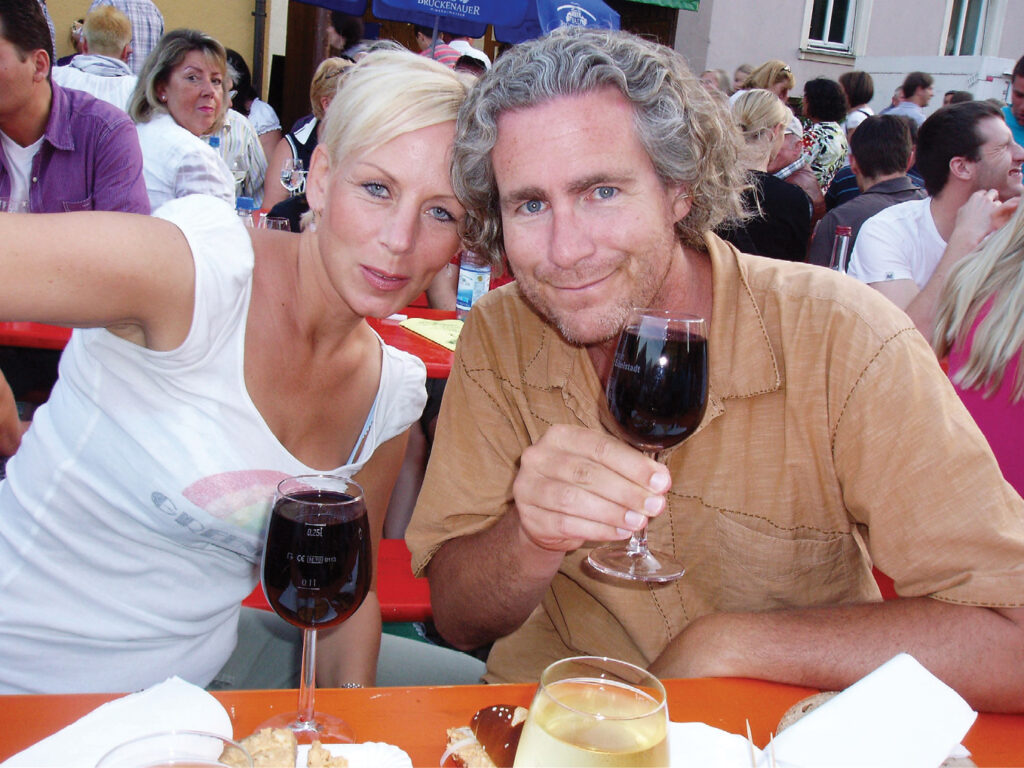
The first supper. Martin and Silke toast the formation of the new company by attending the Sommerhausen wine festival in 2012. This annual event—not a bacchanal but a celebration of fine food and wine—takes place every autumn. My goodness, that’s a strong pour!
Return home—charting the course
Martin’s return home was riddled with desolation, yet it marked the beginning of a prolific phase, lasting more than ten years, of both software and commercial development of his ideas. He realized that he had to make a living now he was back at the family home in Sommerhausen and wisely decided to leverage his lidar expertise. Programming LAStools kept him alive—he was hardly interested in anything else. With the progress of LAStools, Martin’s condition stabilized, and he regained perspective. The founding of rapidlasso GmbH in September 2012 marked a turning point. From then on, there was only one direction: forward. The company was registered in Munich, because funding for an ongoing project came from the German Aerospace Center, DLR7.
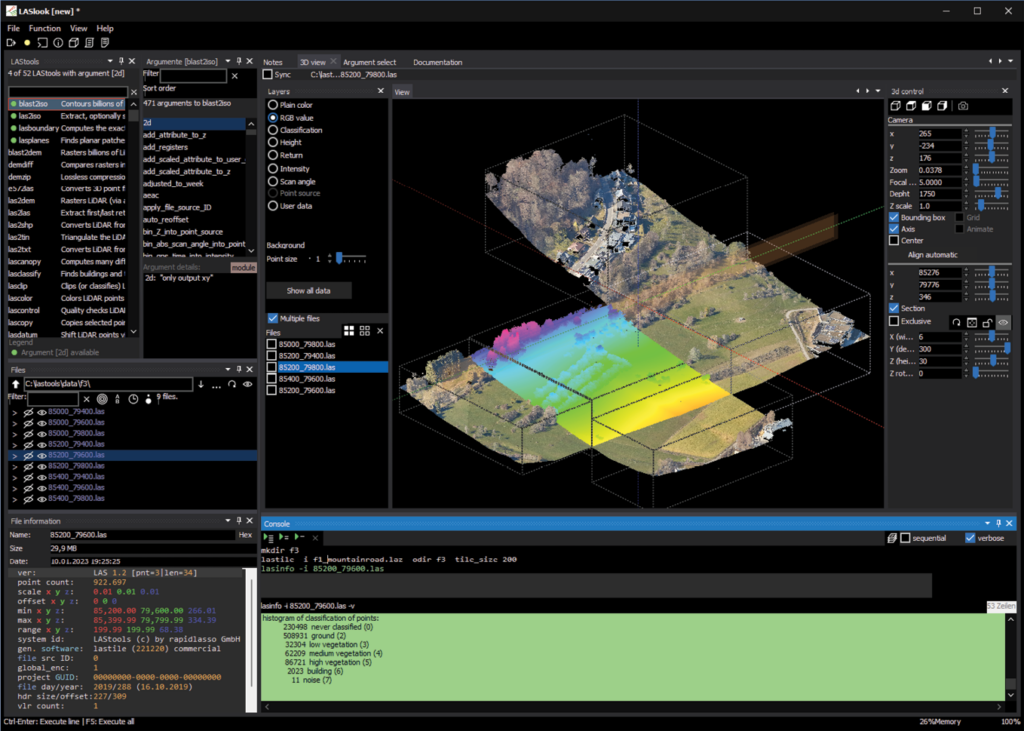
rapidlasso announced a graphical user interface for the software in June 2022, the most significant development since Jochen came on board.
Martin expanded rapidlasso into a successful company and enjoyed himself hugely, writing code and giving lectures, seminars and training courses across the globe, non-disposable coffee cup always to hand. Martin generously shared his knowledge and helped many young lidar scientists and users to understand lidar in all its aspects. Through his LASmoons program, he gave access to the full version of LAStools to many significant projects.
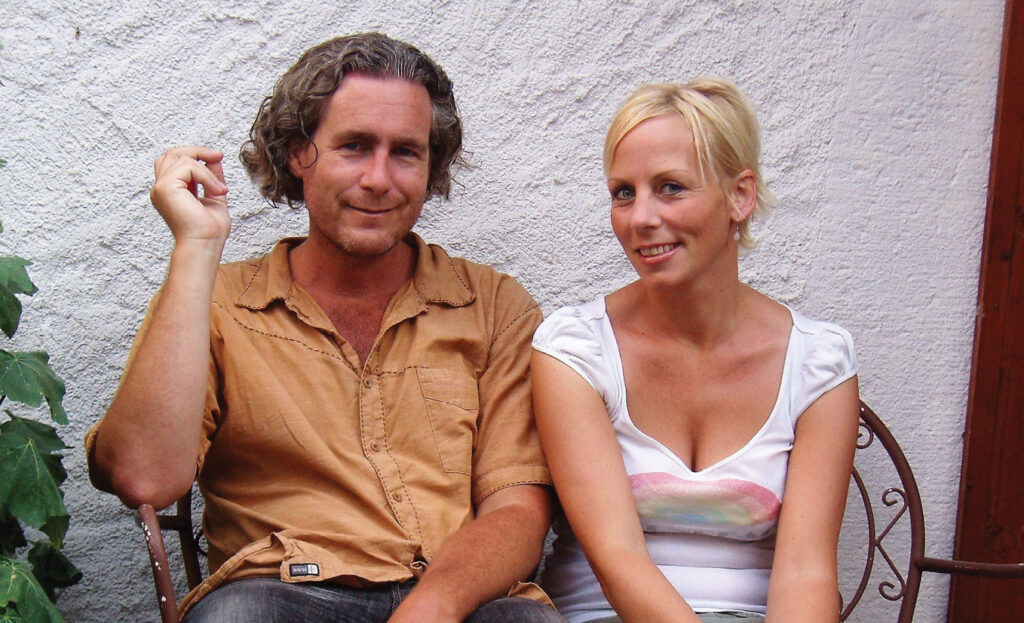
Happy times. Martin and Silke outside Martin’s home in Sommerhausen, Bavaria, after the formation of rapidlasso GmbH
All good things come to an end
A giant enlargement of this pixelated image of Dr. Martin Isenburg was used as the backdrop in the rapidlasso booth at the Intergeo expo and conference, Essen, Germany, 10-12 October 2022.
Martins‘s craving for the sun led him to buy a vacation home in Sámara, on the Pacific coast of Costa Rica, in 2016, where he spent his vacations writing code in the mornings and surfing in the afternoons. In March 2020, during one of these vacations, covid hit. Within a few days, the lockdown caused a spectacular recurrence of Martin’s mental health issues of ten years previously and it appears that he ceased to take his essential medications. He bought a large lot in Sámara, raised chickens and revived the idea of his “laser chicken” online project from ten years before. Again, he broke with family and friends. Again, bizarre behaviors and communications occasioned pushback from customers and contacts not only in the Sámara community around his vacation home, but also in the wider lidar world. When Martin’s manic episode suddenly ended in summer 2021, he fell into a deep depression, which is characteristic of the course of bipolar disorders. Realizing how his mental illness had once again wrecked his life, he felt threatened and tied down by his own body. He lost all hope and ended the pain.
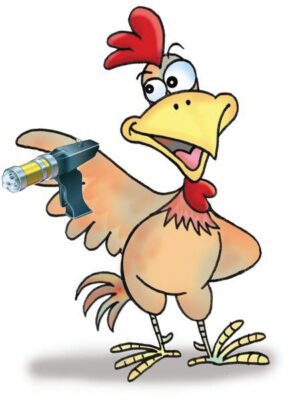
Martin’s avatar, the “laser chicken” he created in his first mania in 2010. It became quite famous. He gave laser-chicken talks on YouTube and in a conference, and even printed business cards.
His family in Germany, from whom Martin did not accept any help during his mania, as had happened 10 years earlier, was completely in shock after receiving the terrible news. In addition to the sadness and helplessness over Martin’s death, there was a mountain of tasks to be faced. Customers whose licenses were about to expire sought contact via all possible channels and wanted to know what was going to happen. Silke remembers those days: “We sat in Martin’s father’s house in despair, discussing how to proceed. It was clear to everybody that Martin had left a tremendous legacy and there was a great sense of responsibility towards customers and users. However, it was also clear that Martin’s family would not continue to run the company. When I finally said I didn’t know how, but I would do it, I heard the heavy stone rolling away. This process had elements of déjà vu compared to 11 years ago, but the difference was that this time it was terrifyingly final.”
Silke had endured a difficult time herself. Her beloved father, whose carer she had been for two and a half years, had died of leukemia shortly before Martin’s death. In addition, she was a newcomer to the lidar industry and had to start from scratch. Martin had left no instructions—there were only a few folders of old receipts together with Martin’s computers and hard drives, which Martin’s father and his wife checked for relevant content. Fortunately, Silke’s partner, a successful entrepreneur with an extensive network, was able to pull a contact person out of the hat for almost every task. Another source of support in those early days was Howard Butler. Silke elaborated: “Since it was the only name I could remember from Martin’s professional contacts of ten years ago, I googled Howard and contacted him shortly after Martin’s death. Having no idea about lidar made me feel like an idiot in the presence of specialists, but Howard patiently answered all my questions. Fortunately, I learn quickly and I haven‘t doubted or regretted my decision for a second. It would be a shame not to continue Martin’s impressive legacy. Unfortunately, that’s the last thing I can do for him.”
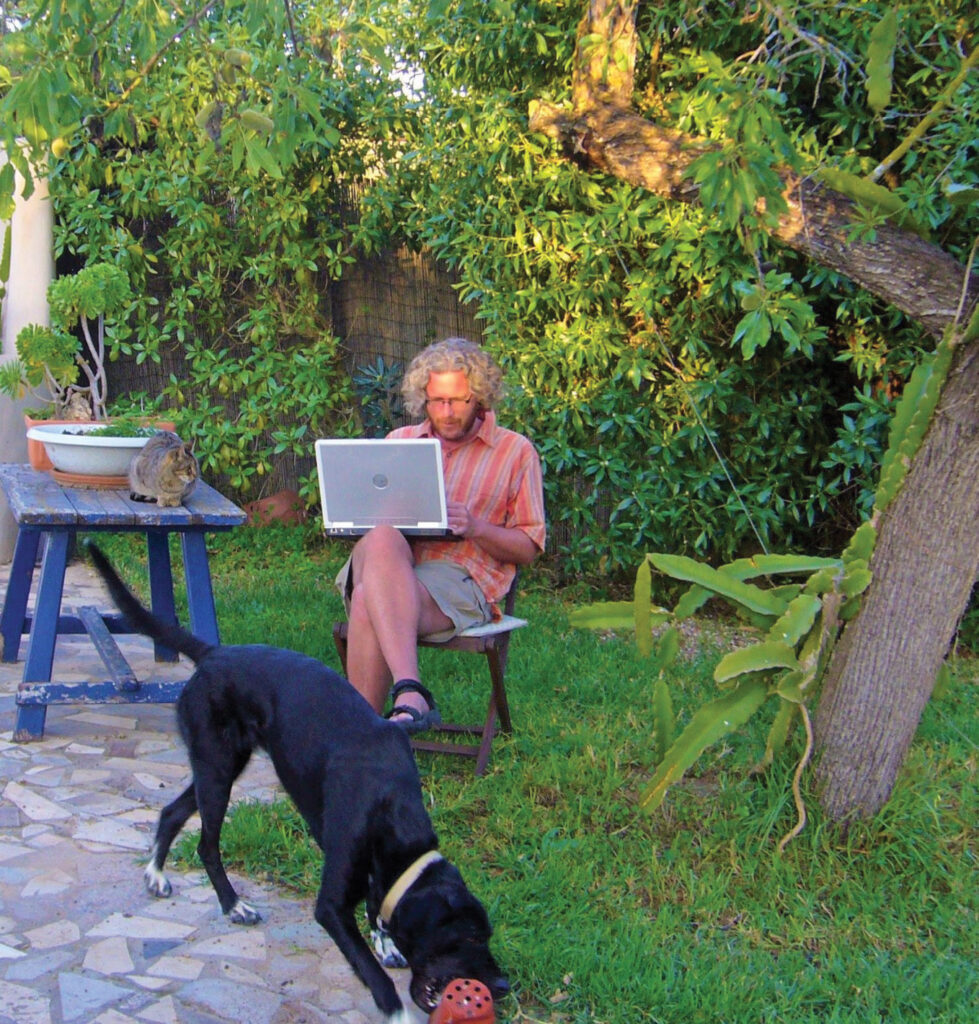
Silke was in Ibiza in February 2011, staying in a finca with elements of a communal lifestyle such as group dinners, while she pursued a Spanish language course. Martin followed along, to escape the dreich German winter. He sat in this corner every afternoon to catch the last rays before the sun went down, programming LAStools.
rapidlasso today—fast tools to catch reality
Howard Butler explained8, “By constructing out-of-core techniques for processing large geometry data collections, Martin was able to demonstrate memory-efficient tools to chew through the oncoming rush of lidar data captures beginning to appear for natural science and morphological uses.”
The rapidlasso portfolio consists of three product lines, LAStools, BLAST and LASzip.
LAStools
LAStools, the flagship product, is a collection of highly efficient, batch-scriptable, multicore command-line tools for processing point clouds. It includes more than 50 tools to classify, convert, filter, raster, triangulate, contour, clip, and polygonize lidar data—to name just some. All tools can be run from the command line via a native GUI or via toolboxes (e.g. QGIS, ArcGIS, FME, ERDAS IMAGINE).
LAStools are popular for their blazing speed and high productivity. The software combines robust algorithms with efficient I/O and memory-efficient management to achieve high throughput for datasets containing billions of points. The software runs on Windows and Linux. It has deep market-penetration and is widely used across industry, government agencies, research labs, and educational institutions. The ability to script the modules makes them ideal for use on web servers or in the cloud.
BLAST
The BLAST extension of LAStools consists of two highly efficient, batch-scriptable, multicore command-line tools. BLAST is the fastest and most memory-efficient solution to process billions of lidar points into DTMs, DSMs, CHMs, or elevation contours. It utilizes unique “streaming TIN” technology to seamlessly triangulate billions of points for subsequent rasterization into a DEM with blast2dem or extraction of elevation contours with blast2iso. The BLAST extension is available for standalone licensing or as an add-on to the LAStools software suite. BLAST can be run from the command line via a native GUI or via toolsboxes (e.g. QGIS, ArcGIS, FME, ERDAS IMAGINE).
LASzip
The open-source lidar compressor LASzip has become the de facto standard for compressed point clouds in the lidar industry. Winner of the 2012 Geospatial World Forum Technology Innovation Award for LiDAR Data Processing, LASzip squeezes the 5.3 TB of LAS files that the National Land Survey of Finland serves on its public servers as part of an “open data” campaign into only 0.8 TB of LAZ files. Other success stories are OpenTopography, which has been serving LAZ for two years, and the comprehensive open lidar archive of the Minnesota Department of Natural Resources, which is exclusively provided in the LAZ format.
LASzip is completely lossless: a LAS file can be compressed into LAZ, then uncompressed into a bitwise identical LAS file. Another advantage is that the user can treat compressed LAZ files just like standard LAS files. They can be loaded directly from compressed form into an application without needing to decompress them on to disk first.
LASzip is offered as a laszip.exe Windows binary and as a minimalistic open-source code distribution (since November 1, 2021, LASzip has been licensed under the Apache Public License 2.0). LASzip is also available through its tight integration with LASlib—the core library used by LAStools. A standalone DLL for adding LAZ support to other software packages can be built from source.
The new team assembles
We traveled to Germany in October 2022 to find the company thriving9,10. The intellectual property and the company passed to Dieter, Martin’s father, who had been a photogrammetrist in his early days. Dieter appointed Silke CEO and she abandoned a successful career in aviation to step into the role. An experienced engineer, Jochen Keil, was recruited to lead the software effort. Jochen, who had spent time with Mercedes Benz developing automotive software, including user interfaces and databases, mastered Martin’s code, and began to develop new functionality while familiarizing himself with lidar and introducing himself to the community, for example by participating in the ASPRS LAS Working Group. On taking up his new position, Jochen commented, “After many years in various areas of industrial software, it was a great pleasure for me to enter a different area of application and I am looking forward to the challenge.”
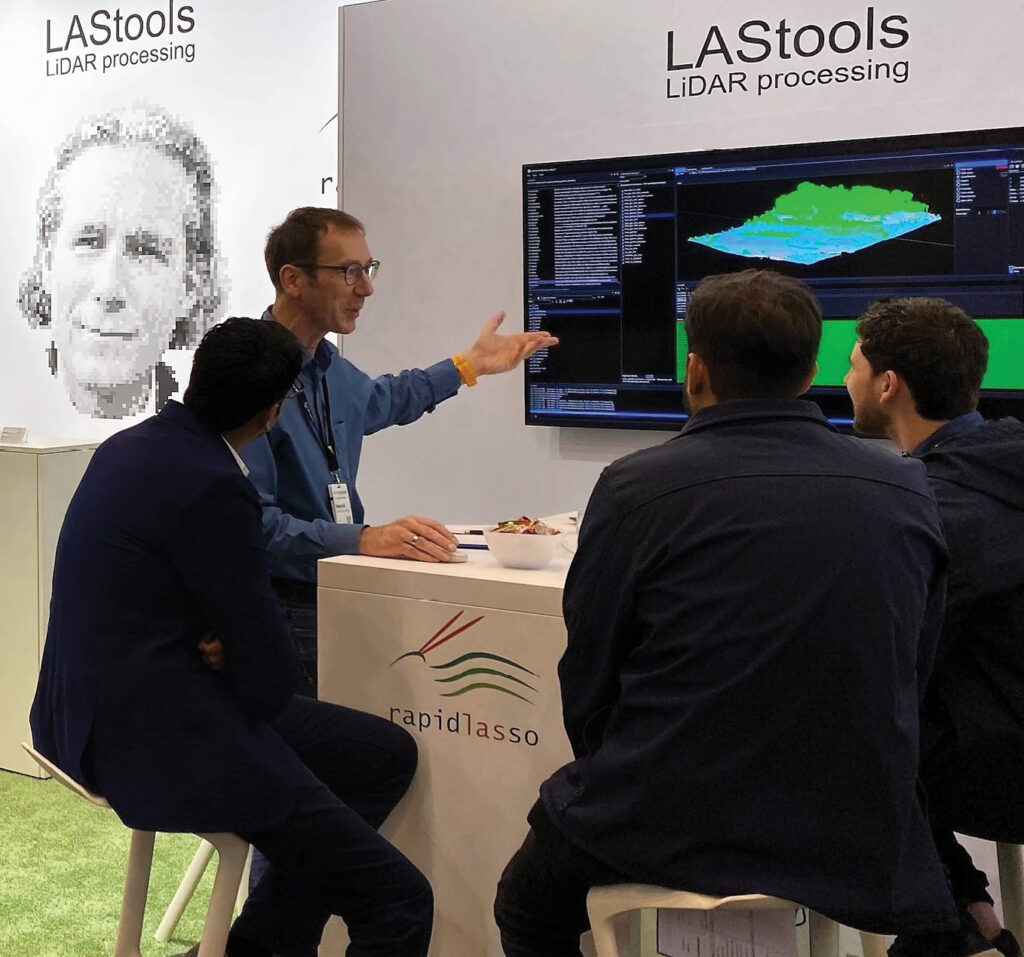
Jochen Keil, senior software engineer, explains rapidlasso software and new features to customers on the company’s booth at the Intergeo trade show and conference, Essen, Germany, October 2022.
The company is moving fast. Various product improvements have been rolled out, especially a new GUI and a Linux version of the code. Several new tools are nearing release. No less than 52 video tutorials for all existing tools are in progress. The customer database has been significantly upgraded. Fortunately, the company has been able to continue Martin’s philanthropic work through the LASmoons program and the granting of licenses to eligible projects.

These fabulous lidar visualizations of the remarkable Angkor Wat temple complex in Cambodia were generated using software from BayesMap Solutions* and rapidlasso. They form deliverables in a project being conducted by École Française d’Extrême-Orient (EFEO†). The subcontractor was Khmer Geographic Institute (KGI)‡. * http://bayesmap.com | † https://www.efeo.fr | ‡https://kgi.xyz
All this requires energy and talent. Silke is responsible for all strategic decisions and ensures that the company continues in Martin’s spirit. A team of software developers around Jochen takes care of the maintenance and further development of the software. A web developer is currently building a new website11. An administrator and an accountant complete the team. In addition, rapidlasso receives massive support and advice from countless experts in the lidar community, many of them former acquaintances and friends of Martin.
Almost two years after Martin’s death, rapidlasso is financially and technologically stable and takes its deserved place in the lidar world with people, products and communication. Profits are re-invested to accelerate the course of development. The stream of existing and prospective customers seeking information and advice on the rapidlasso booth during the Intergeo event in Essen in October 2022 bore witness to the hunger for the capabilities that Martin created and nurtured. The new team seems well able to respond to the demand, while injecting a stream of fresh features in the years to come.
If you or someone you know is having thoughts of suicide, visit www.findahelpline.com for a global list of resources.
4 Isenburg, M., Y. Liu, J. Shewchuk and J. Snoeyink, 2006. Streaming computations of Delaunay triangulations, SIGGRAPH 2006, 8 pp.
5 Isenburg, M, 2013. LASzip: rapid compression of lidar data, Photogrammetric Engineering & Remote Sensing, 79(2): 209-217.
6 Silke’s more personal thoughts about Martin were summarized in her address after receiving, on his behalf, the Lidar Leader Award for Outstanding Personal Achievement in Lidar in 2022: https://lidarmag.com/2023/01/18/the-martin-i-knew/.
7 Deutsches Zentrum für Lauf- und Raumfahrt.
8 Butler, H., 2022. In memoriam: Martin Isenburg, 1972-2021, LIDAR Magazine, 11(5): 46-48.
